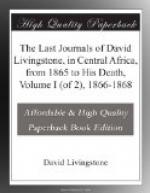But few of the sponges on the watershed ever dry; elsewhere many do; the cracks in their surface are from 15 to 18 inches deep, with lips from 2 to 3 inches apart. Crabs and other animals in clearing out their runs reveal what I verified by actually digging wells at Kizinga and in Kabuire, and also observed in the ditches 15 feet deep dug by the natives round many of their stockades, that the sponge rests on a stratum of fine white washed sand. These cracks afford a good idea of the effect of the rains: the partial thunder-showers of October, November, December, and even January, produce no effect on them; it is only when the sun begins to return from his greatest southern declination that the cracks close their large lips. The whole sponge is borne up, and covers an enormous mass of water, oozing forth in March and April forming the inundations. These floods in the Congo, Zambesi, and Nile require different times to reach the sea. The bulk of the Zambesi is further augmented by the greater rains finding many pools in the beds of its feeders filled in February, as soon as the sun comes north.
Mem.—In apparent contradiction of the foregoing, so far as touches the sources of the Zambesi, Syde bin Habib informed me a few days ago that he visited the sources of the Liambai and of the Lufira. Each comes out of a fountain; the Lufira one is called Changozi, and is small, and in a wood of large trees S.W. of Katanga; the fountain of the Liambai is so large that one cannot call to a person on the other side, and he appears also very small there—the two fountains are just five hours distant from each other. He is well acquainted with the Liambai (Leeambye), where I first met him. Lunga, another river, comes out of nearly the same spot which goes into the Leunge, Kafue (?). Lufira is less than Kalongosi up there; that is less than 80 or 200 yards, and it has deep waterfalls in it. The Kone range comes down north, nearly to Mpmeto’s. Mkana is the chief of the stone houses in the Baloba, and he may be reached by three days of hard travelling from Mpweto’s; Lufira is then one long day west. As Muabo refuses to show me his “mita,” “miengelo,” or “mpamankanana” as they are called, I must try and get to those of the Baloba of Mkana.
Senegal swallows pair in the beginning of December.
Note.—Inundation.
The inundation I have explained in the note on the climate as owing to the sponges being supersaturated in the greater rains, when the sun returns from his greatest southern declination, the pores are then all enlarged, and the water of inundation flows in great volume even after the rains have entirely ceased. Something has probably to be learned from the rainfall at or beyond the equator, as the sun pursues his way north beyond my beat, but the process I have named accounts undoubtedly for the inundations of the Congo and Zambesi. The most acute of the ancients ascribed the inundation with Strabo to summer rains in the south; others to snows melting on the Mountains of the Moon; others to the northern wind—the Etesian breezes blowing directly against the mouth of the river and its current: others, with less reason, ascribed the inundation to its having its source in the ocean: Herodotus and Pliny to evaporation following the course of the sun.




